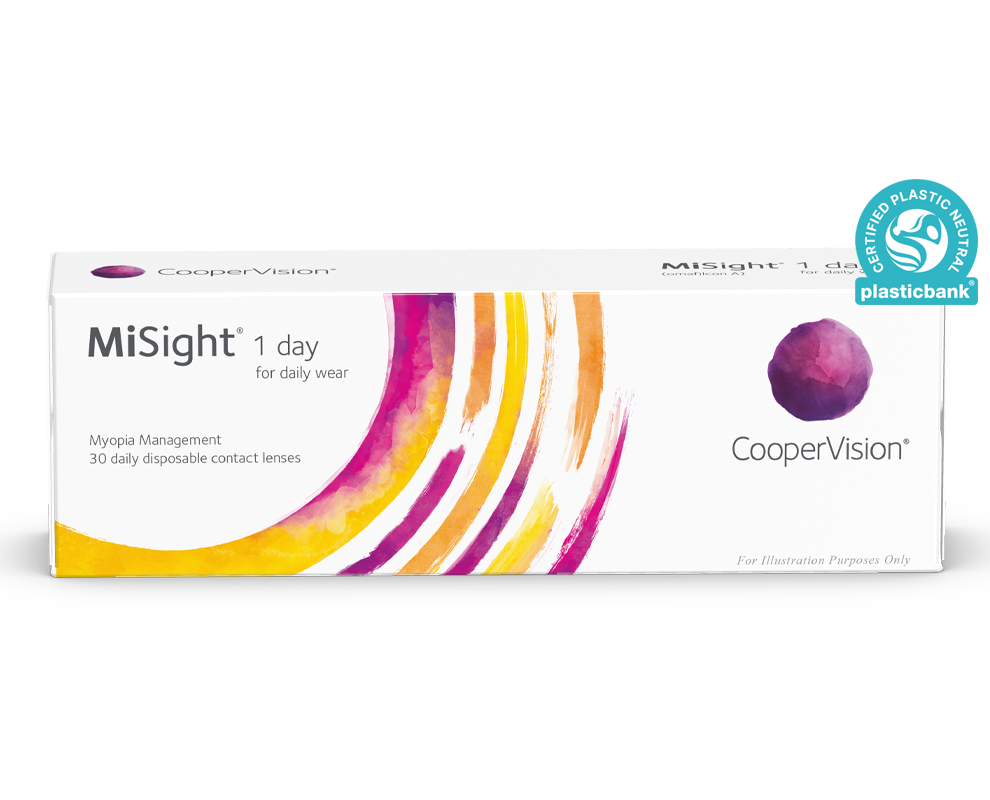說明
MiSight® 1 day 每日即棄隱形眼鏡,專為有近視的兒童而設1-3
特色與優點
- 科學證實,有效減慢近視加深速度約50% †‡2,4
- 幾乎適用於所有近視兒童‡2
- 佩戴隱形眼鏡能有助於達到近視控制治療§5,6
- ActivControl® Technology 有針對兒童使用軟性隱形眼鏡最長的7年研究支持7
- 任何年齡的兒童開始治療後,均可見效 (8歲以上)◊¶3,8
- 兒童友好,易於佩戴和使用 **1,9
- 適合兒童精彩的生活方式§5
- 隱形眼鏡令孩子對外表變得自信,同時改善社交生活10

| 技術ActivControl® Technology 既能提供清晰視力,又有助於控制兒童眼軸增長和近視加深.1 |
近視控制
兒童近視是一種漸進性疾病,其盛行率和嚴重程度都在增加。11 我們必須採取行動,因為近視是不可逆轉的。現時每兩個兒童就有一個可能在 20 歲時患上近視。11,12 儘早解決兒童近視問題有助於降低日後罹患近視相關眼睛疾病的風險,包括視網膜脫落、近視黃斑病變、青光眼和白內障。13-16
產品詳細資料
-6.00D至 -0.25D (0.25D一級)
包裝圖片僅供參考。
塑膠重量定義為參與計劃的CooperVision 軟性隱形眼鏡產品的塑膠重量,包括吸塑膠殼、鏡片和外層包裝塑膠,包含層壓材料、黏合劑和輔助劑 (例如墨水)。不包括這些產品及其包裝在製造過程中使用的塑膠。‡‡ 17
有關醫療器械安全、警告、注意事項和當地法規資訊,請參閱使用說明書。
* Compared to a single vision 1 day lens over a 3 year period.
† Using measured and modeled data, pooled across ages (8-17), MiSight® 1 day slowed myopia progression by an average of approximately 50%.
‡ 90% of myopic eyes respond to MiSight® 1 day treatment; ages 11-15 at initiation of treatment, n=90.
§ In clinical study, mean weekday wear time increased from 12.8 hours/day at 6-months to 13.9 hours/day at 6-years with a mean of >6.5 days/week.
◊ Children with myopia fit with MiSight® 1 day contact lenses ages 8-15 continued to experience slowed myopia progression as long as they remained in treatment.
¶ 12 months post-treatment, evidence indicates that no accumulated myopia control benefits were lost following 3 or 6-years of MiSight® 1 day wear (on average, for children aged 8-15 at start of wear). Instead, eye growth reverted to expected, age average myopic progression rates.
** Initial CL BVP selection and observation of fit follows same fitting protocol for single vision CLs; fit success rate same with MiSight® 1 day and Proclear® 1 day.
‡‡ Plastic used in participating CooperVision soft contact lens products is determined by the weight of plastic in the blister, the lens, and the secondary package, including laminates, adhesives, and auxiliary inputs (e.g. ink). The determination does not include plastic used during the manufacturing process for both these products and their packaging.
References:
1. Chamberlain P, et al. A 3-year randomized clinical trial of MiSight® lenses for myopia control. OVS. 2019; 96(8):556-567
2. Chamberlain P, et al. Long-term Effect of Dual-focus Contact Lenses on Myopia Progression in Children: A 6-year Multicenter Clinical Trial. OVS 2022 Mar 1;99(3):204-212.
3. Chamberlain P, Arumugam B, et al. Myopia progression on cessation of Dual-Focus contact lens wear: MiSight 1 day 7 year findings. OVS 2025 In Press;98:E-abstract 210049.
4. Arumugam B et al. Modelling Age Effects of Myopia Progression for the MiSight 1 day Clinical Trial. IOVS 2021;62(8):2333.
5. Woods J et al. Ocular health of children wearing daily disposable contact lenses over a 6-year period. CLAE 2021 Aug;44(4):101391.
6. Lumb E, et al. Six years of wearer experience in children participating in a myopia control study of MiSight® 1 day. CLAE 2023; 46(4): 101849.
7. CVI data on file, 2025.
8. Hammond D, Arumugam B, et al. Myopia Control Treatment Gains are Retained after Termination of Dual-focus Contact Lens Wear with no Evidence of a Rebound Effect. OVS 2021;98:E-abstract 215130.
9. CVI data on file 2018
10. Walline J, et al. Randomized trial of the effect of contact lens wear on self-perception in children. Optom Vis Sci. 2009 Mar;86(3):222-32.
11. Holden BA, Fricke TR, Wilson DA, et al. Global prevalence of myopia and high myopia and temporal trends from 2000 through 2050. Ophthalmology. 2016;123(5):1036-1042.
12. K. Zadnik et al. Factors Associated with Rapid Myopia Progression in School-aged Children. IOVS 2004;45(13):2306.
13. Xu L et al. High myopia and glaucoma susceptibility, the Beijing Eye Study. Ophthalmology. 2007;114(2):216-20.
14. Flitcroft DI. The complex interactions of retinal, optical and environmental factors in myopia aetiology. PRER 2013;31(6):622-60.
15. Younan C, et al. Myopia and incident cataract and cataract surgery: the blue mountains eye study. IVOS 2002;43(12):3625-3632.
16. Chen SJ, et al. Prevalence and associated risk factors of myopic maculopathy in elderly Chinese: the Shihpai eye study. IOVS 2012;53(8):4868-73.
17. CVI data on file, 2024.
SA15164/ APP148768


